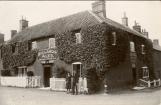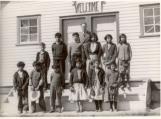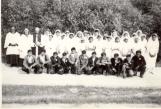1
Hotel and Tavern where Sam was born7 August 1933
Neatestead, Norfolk, England
 Credits:
Credits:Sam Waller Museum Collection
2
Sam Waller, known to many as "Mr. Museum", was one of the greatest contributors to preserving the history of The Pas as well as Lake St. Martin, Moose Factory, Cedar Lake, and Jackhead Mission. He was a World War I veteran, a missionary, teacher, linguist, ornithologist, philatelist, musician, author, and curator. Whether teaching or taking care of his beloved collection due to his dedication and passion his efforts are still leaving an impact on visitors to the museum today.Sam Waller was born the son of typical British working class parents Amelia and Samuel Sr., the owner of the Crown Hostel in Bildeston, England on 23 June 1895 in Netishead, Norfolk, England but was raised by his father and stepmother Nellie. He attended Northgate High School in Ipswich but was considered a "dull student" by many of his teachers and spent a great deal of time in detention because of it. Eventually in 1909 he started an apprenticeship with J&J Edwards on Tavern Street. This apprenticeship was short-lived though, as on 22 March 1911 Sam immigrated to Canada on the S.S. Royal George at age sixteen and worked on a Quaker farm near Wooler, Ontario for a year. New arrivals to Canada were required to work on farms and Sam was paid $5 per year plus room and board, although after some negotiation his yearly salary was raised to $25. Eventually in 1913 Sam started work in a small store in Codrington, Ontario, though by 1914 he had moved to Brighton to work in a small store there. He also served as lay reader and organist at St. Paul's church.
5
At the onset of the First World War Sam joined the military and was part of the Expeditionary Force. When he arrived in France on 15 April 1917 he served in the 29th Vancouver Battalion as a stretcher-bearer and orderly. It was here that he found his passion for collecting, as well as a fear of mud. During the War, Sam managed to collect a slip of paper dropped by German forces to upset the Allied radio locations. He then carried this "souvenir" with him for the rest of the War and it is quite possibly the start of what would become an incredibly extensive collection. In the War he received a military medal for bravery for his participation in the Battle of Amiens on the 9th of August 1918. While in the army, he also matriculated from Khaki University - a Canadian educational institution set up during the War. At the end of the War in 1919 Sam was discharged and he returned to Canada.7
Sam Waller Wearing Lay Reader Gowncirca 1915
Cobourg, Ontario, Canada
 Credits:
Credits:Sam Waller Museum Staff
F. J. Skitch
8
Upon his return from the War, Sam sought a Bachelor of Arts at Trinity College in Toronto, but unfortunately failed to graduate, due to poor health. This occurrence would end his formal education, but Sam never really stopped studying. He continued to learn through his own field studies, learning as much as he could about the area in which he lived.After Trinity College Sam went to work at the Canadian National Carbon Company, a battery factory in Toronto. He greatly enjoyed the work. Since he was already a devout Anglican, it was during this time at St. Monica's Anglican Church where he served as lay reader that he became interested in missionary work through the capacity of teaching.
In 1923 to 1930 Sam had his first teaching position at the Anglican Residential School in Moose Factory, James Bay, Ontario across the river from the Northwest Company as a teacher and lay missionary. It was so isolated that it could only be reached by canoe and mail was a centralized part of everyday life. It was the only connection the people of Moose Factory had to the rest of the world. In fact life in Moose Factory often centered on the arrival of mail. Fights and bad moods were blamed on the mail being late and school would be let out early. Due to the isolation of Moose Factory Sam would return periodically to Toronto to visit friends. Sam also started to build up his collection here, as well as starting to learn Cree, finding that it was helpful in teaching his students. It was in Moose Factory that he started to develop relationships with the Royal Ontario Museum through correspondence. Much of Sam's collection consisted of animal specimens that he would prepare himself. Almost all of the specimens were prepared on a kitchen table with a kerosene lamp. Sam would send his specimens away and have them verified or identified by various institutions and as he built up relationships with museums around the world, they would trade specimens with one another. He donated and traded specimens with the Royal Ontario Museum, National Museum of Canada, the Manitoba Museum, the Collections of the University of British Columbia, and with various museums around the world.
9
Sam Waller in Uniform25 March 1919
Ripon, England
 Credits:
Credits:Sam Waller Museum Collection
J. K. (?) Bayley
10
While teaching in Moose Factory Sam bought a gun and traps and learned to hunt, trap, and snare, mostly from his older students and other locals. He became well known for his collecting and trappers would donate specimens or pieces of them to him, in which he would always write narrations about them in his journal (if he liked them, how he got them, if they were easy/hard to skin, nesting habits). Sam also liked to record regular bird sightings and would canoe and portage up the line, keeping a diary about any animals or signs of animals. He also extensively photographed the area and its people.Sam's love of teaching and students is very evident. Once he drew caricatures of his students and showed them all after Lantern Services at Christmas. That Christmas he also dressed up as Santa Claus.
While teaching in the Anglican Residential School, Sam's classes could range from 42-79 students at a time. Through his interaction with his students and the community he began to realize, that especially in remote reserves, there was a different etiquette. For example it was considered rude to ask a person, "What is your name?" Instead you should ask a third person, "What is his name?" This discrepancy in manners was part of the reason that many teachers found it hard to adapt to teaching in remote communities in the North. It was also common in these communities to treat the children simply as small adults, capable of being responsible for and making their own decisions. When Sam once asked a father if his daughter was going to be returning to school the next year the father's response was simply, "I don't know. I haven't asked her yet."
11
Sam with Students at Big Eddy Day Schoolcirca 1940
Opaskwayak Cree Nation, Manitoba, Canada
 Credits:
Credits:Sam Waller Museum Collection
12
Regardless of cultural adjustments and societal differences, Sam genuinely cared about his students. He would hunt and trap with them and dress up as Santa for them at Christmas. He was even with George McCloud on his deathbed. Along with teaching duties, he was expected to conduct church services and perform first aid duties. Sam was highly respected in Moose Factory, as shown by his rise to Vice-Principal and eventually acting Principal.After seven and a half years in Moose Factory, Sam went to teach and serve as lay missionary at Lake St. Martin Indian School in Gypsumville, Manitoba in 1930. A Mountie there thought he would only last six months. He stayed seven years. It was here that Sam co-wrote "The Birds of Lake St. Martin" with Terry Shortt, published by the Royal Ontario Museum, and spent a great deal of time working on a Cree hymn book with the help of school handyman Sydney Archibald, and the Native catechist, Fred Mark. He was also a constant visitor to the sick and regularly attended prayers and hymn singing at Native homes.
In 1937 Sam moved to Jackhead Mission, Manitoba; ninety miles from the nearest rail point at Koostatak. He soon found that Jackhead had a much different way of doing things. It was a very isolated community, physically as well as culturally, and he often found himself teaching to an empty classroom during fishing or hunting season, as most of his students went out with their parents. Sam also faced greater resistance to his efforts for proselytization, the children encountered greater difficulties with the language shift, and he had to hire someone to go for his mail. At one point Sam even went so far as to attempt to hire a male companion to accompany him to Jackhead and share his "meager income", but with no success. On his first trip out in the summer of 1938, Sam even requested from the Inspector of Indian Agencies a definite assurance he would not be asked to return to Jackhead after the teaching year, however he did receive many letters of regret when he later left for his next teaching post.
13
Confirmation at Devon Missioncirca 1942
The Pas, Manitoba, Canada
 Credits:
Credits:Sam Waller Museum Collection
14
One of the benefits of this extreme isolation, was Sam had time to write. It was here that Sam wrote stories such as "Dennis in the Northland" (~1937), "Gallio cared for none of these things" (1944) "Parson Heddy's Christmas" (1947), and "Christmas at Jackhead" and poems such as "life consisteth not in the abundance of things we possess" (1937) and "Others laboured, and ye are entered into their labours" (1938).However, Sam had more than just teaching responsibilities. He was also responsible for distributing medicine and the upkeep of the small one room schoolhouse and others.
In 1939 (the beginning of WWII) Sam left Jackhead Mission for the Residential MacKay School at Big Eddy just north of The Pas and then as principal at The Pas Indian Day School in 1942 when it burnt down. He was paid $80.00 per month and he had to get a "War Job" during the school holidays in order to have enough money. It was here that Sam continued to amass his collection and began to consider the idea of starting a museum.
During the summer of 1954, Sam moved his collection into a schoolroom of the Annex and stayed at the Rupert House then he relocated to the Chemawawin Indian Day School at Cedar Lake for a brief period. It was his first time teaching away from his collection, but he continued collecting new specimens while he was there. Now that Cedar Lake is flooded out, the specimens he collected are the only records from the area. He relied on the trader Pete Pouliot for his mail and transportation to and from The Pas.


